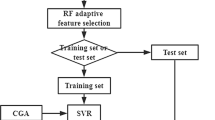Abstract
Typhoon track prediction has mostly been achieved using numerical models which include a high degree of nonlinearity in the computer program. These numerical methods are not perfect and sometimes the forecasted tracks are far from those observed. Many statistical approaches have been utilized to compensate for these shortcomings in numerical modeling. In the present study, a support vector machine, which is well known to be a powerful artificial intelligent algorithm highly available for modeling nonlinear systems, is applied to predict typhoon tracks. In addition, a couple of input dimension reduction methods are also used to enhance the accuracy of the prediction system by eliminating irrelevant features from the input and to improve computational performance.
Preview
Unable to display preview. Download preview PDF.
Similar content being viewed by others
References
Aberson, S.D.: The Prediction of the Performance of a Nested Barotropic Hurricane Track Forecast Model. Weather and Forecasting 12, 24–30 (1997)
Elsberry, R.L., Boothe, M.A., Ulses, G.A., Harr, P.A.: Statistical Postprocessing of NOGAPS Tropical Cyclone Track Forecasts, vol. 127, pp. 1912–1919 (1999)
Sohn, K.-T., Baik, J.-S., Kim, Y.-S.: Estimation of Typhoon Track using Bivariate State Dependent Model. Korean Journal of Atmospheric Sciences 35(4), 613–618 (1999)
Bessafi, M., Lasserre-Bigorry, A., Neumann, C.J., Pignolet-Tardan, F., Payet, D., Lee-Ching-Ken, M.: Statistical Prediction of Tropical Cyclone Motion: An Analog-CLIPER Approach. Weather and Forecasting 17, 821–831 (2002)
Sohn, K.-T., Kwon, H.J., Suh, A.-S.: Prediction of Typhoon Tracks Using Dynamic Linear Models. Advances in Atmospheric Science 20(3), 379–384 (2003)
Baik, J.-J., Paek, J.-S.: Performance Test of Back-propagation Neural Network in Typhoon Track and Intensity Prediction. Korean Journal of Atmospheric Sciences 3(1), 33–38 (2000)
Kim, J.H.: A Study on the Seasonal Typhoon Activity using the Statistical Analysis and Dynamic Modeling. Ph.D Thesis, Seoul National University (2005)
Jolliffe, I.T.: Principal Component Analysis. Springer, New-York (1986)
Goswami, J.C., Chan, A.K.: Fundamentals of Wavelets. Willey-Interscience Publication, New York (1999)
Author information
Authors and Affiliations
Editor information
Editors and Affiliations
Rights and permissions
Copyright information
© 2005 Springer-Verlag Berlin Heidelberg
About this paper
Cite this paper
Song, HJ., Huh, SH., Kim, JH., Ho, CH., Park, SK. (2005). Typhoon Track Prediction by a Support Vector Machine Using Data Reduction Methods. In: Hao, Y., et al. Computational Intelligence and Security. CIS 2005. Lecture Notes in Computer Science(), vol 3801. Springer, Berlin, Heidelberg. https://doi.org/10.1007/11596448_74
Download citation
DOI: https://doi.org/10.1007/11596448_74
Publisher Name: Springer, Berlin, Heidelberg
Print ISBN: 978-3-540-30818-8
Online ISBN: 978-3-540-31599-5
eBook Packages: Computer ScienceComputer Science (R0)




